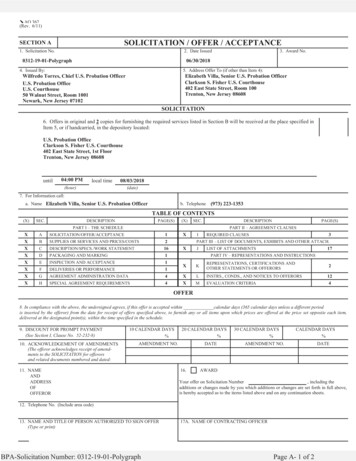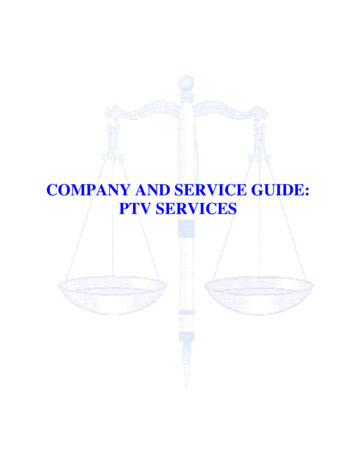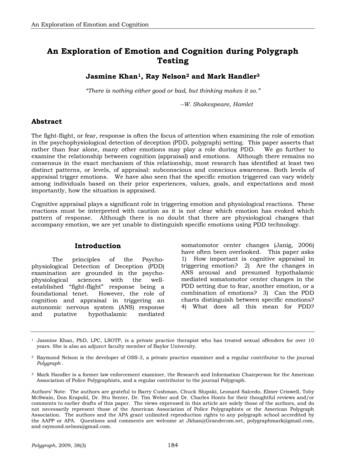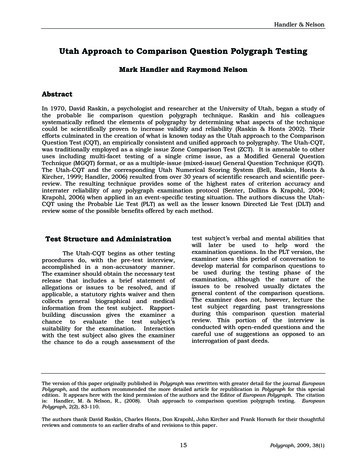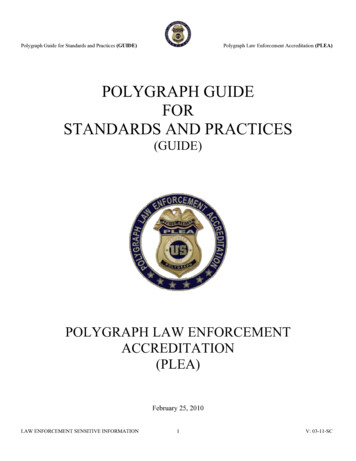
Transcription
Polygraph Guide for Standards and Practices (GUIDE)Polygraph Law Enforcement Accreditation (PLEA)POLYGRAPH GUIDEFORSTANDARDS AND PRACTICES(GUIDE)POLYGRAPH LAW ENFORCEMENTACCREDITATION(PLEA)February 25, 2010LAW ENFORCEMENT SENSITIVE INFORMATION1V: 03-11-SC
Polygraph Guide for Standards and Practices (GUIDE)Polygraph Law Enforcement Accreditation (PLEA)TABLE OF CONTENTSPage C1. CHAPTER 15 INTRODUCTIONC1.1. CONCEPT FOR USE OF POLYGRAPH BY THE LAW ENFORCEMENTACCREDITATION PROGRAM (PLEA)C1.2. SCOPEC1.3. POLICIES AND PROCEDURES FOR THE CONDUCT OF EXAMINATIONS5 C2. CHAPTER 27 5 5 5 POLYGRAPH EXAMINATIONSC2.1. INVESTIGATOR RESPONSIBILITIESC2.2. AUTHORIZATION FOR THE USE OF A POLYGRAPH EXAMINATIONC2.3. POLYGRAPH APPROVAL PROCEDURESC2.4. PRE-TEST PROCEDURESC2.5. DATA COLLECTION PROCEDURESC2.6. TEST DATA ANALYSISC2.7. POST-TEST PROCEDURESC2.8. MONITORING REQUIREMENTSC2.9. POLYGRAPH INSTRUMENTSC2.10. RECORDING OF EXAMINATIONSC2.11. REPORTS AND DOCUMENTSC2.12. USE OF INTERPRETERSC2.13. AGENCY EXAMINERSC2.14. PRE-EMPLOYMENT EXAMINATIONS7 7 7889101010111111121313C3. CHAPTER 314 QUALITY CONTROLC3.1. SCOPEC3.2. BACKGROUNDC3.3. ADMINISTRATION OF QCC3.4. QC PROCEDURES14 14 14 14 14 C4. CHAPTER 416 TEST QUESTION CONSTRUCTIONC4.1. SCOPEC4.2. BACKGROUNDC4.3. QUESTION TYPES16 16 16 16 LAW ENFORCEMENT SENSITIVE INFORMATION2V: 03-11-SC
Polygraph Guide for Standards and Practices (GUIDE)Polygraph Law Enforcement Accreditation (PLEA)C5. CHAPTER 519 TEST DATA ANALYSISC5.1. SCOPEC5.2. BACKGROUNDC5.3. TEST DATA ANALYSIS19 19 19 19 C6. CHAPTER 621 ACQUAINTANCE TESTC6.1. SCOPEC6.2. BACKGROUNDC6.3. PRETEST PHASEC6.4. DATA COLLECTIONC6.5. TEST DATA ANALYSIS21 21 21 21 22 22 C7. CHAPTER 723 ZONE COMPARISON TESTC7.1. SCOPEC7.2. BACKGROUNDC7.3. PRETEST PHASEC7.4. DATA COLLECTIONC7.5. TEST DATA ANALYSISC7.6. QUESTION STRING SAMPLES23 23 23 23 25 2628C8. CHAPTER31YOU-PHASE ZONE COMPARISON TESTC8.1. SCOPEC8.2. BACKGROUNDC8.3. PRETEST PHASEC8.4. DATA COLLECTIONC8.5. TEST DATA ANALYSISC8.6. QUESTION STRING SAMPLES31 31 31 31 33 3436C9. CHAPTER 937LAW ENFORCEMENT MODIFIED GENERAL QUESTION TEST (LEMGQT)C9.1. SCOPEC9.2. BACKGROUNDC9.3. PRETEST PHASEC9.4. DATA COLLECTION PHASEC9.5. TEST DATA ANALYSISC9.6. QUESTION STRING SAMPLES37 37 37 37 39 4244LAW ENFORCEMENT SENSITIVE INFORMATION3V: 03-11-SC
Polygraph Guide for Standards and Practices (GUIDE)Polygraph Law Enforcement Accreditation (PLEA)C10. CHAPTER 1045LAW ENFORCEMENT PRE-EMPLOYMENT TEST (LEPET)C10.1. SCOPEC10.2. BACKGROUNDC10.3. PRETEST PHASEC10.4. DATA COLLECTION PHASEC10.5. TEST DATA ANALYSISC10.6. QUESTION STRING SAMPLES45 45 45 45 46 4749C11. CHAPTER 1150 COUNTERMEASURESC11.1. SCOPEC11.2. BACKGROUNDC11.3. PROCEDURESC11.4. COUNTERMEASURES TRAINING50 50 50 50 51 C12. CHAPTER 1252POLYGRAPH EXAMINER QUALIFICATIONS:TRAINING, INTERNSHIP AND PROFICIENCYC12.1. TRAININGC12.2. INTERNSHIPC12.3. EXAMINER PROFICIENCYC12.4. CONTINUING EDUCATION52 52 52 5356APPENDIX A TEST QUESTION CONSTRUCTION EXAMPLESAPPN. A.1. HOMICIDE (Shooting)APPN. A.2. HOMICIDE (Unknown cause of Death)APPN. A.3. FORCIBLE RAPEAPPN. A.4. DATE RAPEAPPN. A.5. ARSON INVESTIGATIONAPPN. A.6. LARCENYAPPN. A.7. TERRORIST ACTS54 54 55 565758 59 60APPENDIX B61DEFINITIONS AND TERMS61LAW ENFORCEMENT SENSITIVE INFORMATION4V: 03-11-SC
Polygraph Guide for Standards and Practices (GUIDE)Polygraph Law Enforcement Accreditation (PLEA)C1. CHAPTER 1INTRODUCTIONC1.1. CONCEPT FOR USE OF POLYGRAPH BY THE LAW ENFORCEMENTACCREDITATION PROGRAM (PLEA)The polygraph discipline has become accepted a valuable forensic application within the lawenforcement (LE) and intelligence communities (IC). As with any professional forensicdiscipline, established standardized methodologies should be implemented to ensure properapplication. The polygraph procedures in this Guide detail those standards adopted by the LEagencies that have elected to participate in the PLEA program. Participating agencies recognizethat the procedures in this Guide will help ensure each examination will be conducted in the mostprofessional manner possible while maintaining the polygraph discipline as an effectiveinvestigative tool.C1.2. SCOPENothing in this Guide or referenced materials should be construed to limit the authority ofindividual agency heads to manage their polygraph programs in the manner best suited to theirindividual LE missions. Failure to abide by any or all parts of this Guide shall not give rise toany claim cognizable in a court of law. This Guide is intended only to improve the internalmanagement of LE polygraph programs. It is not intended and does not create any right toadministrative or judicial review or any other right, benefit, trust, responsibility, substantive orprocedural, enforceable by a party against any LE jurisdiction, its officers or employees, or anyother person.C1.2.1. In the event of conflict regarding this Guide and state law or local regulations orrestrictions, state and local guidance should prevail.C1.2.2. Where applicable, a polygraph examiner should be licensed or appropriatelycertified by the LE agency for the jurisdiction in which the examiner conducts polygraphexaminations.C1.3. POLICIES AND PROCEDURES FOR THE CONDUCT OF EXAMINATIONSC1.3.1. Managers participating in the PLEA oversight process have agreed to establishprocedures for the supervision of polygraph programs consistent with this Guide to ensure thehighest ethical, professional, and technical standards.C1.3.2. General principles and specific standards for polygraph examinations arecontained in this Guide and have been adopted by each participating agency.LAW ENFORCEMENT SENSITIVE INFORMATION5V: 03-11-SC
Polygraph Guide for Standards and Practices (GUIDE)Polygraph Law Enforcement Accreditation (PLEA)C1.3.3. Polygraph policies and procedures should address the following:C1.3.3.1. Persons authorized to approve the conduct of polygraph examinationswithin the agency.C1.3.3.2. Procedures for the types of examinations, formats and techniquesauthorized to be conducted by the agency.C1.3.3.3. Procedures for the supervision, certification, and decertification of apolygraph examiner.C1.3.3.4. Quality control procedures.C1.3.4. Requests to modify this Guide should be made in accordance with the by-laws ofthe PLEA.LAW ENFORCEMENT SENSITIVE INFORMATION6V: 03-11-SC
Polygraph Guide for Standards and Practices (GUIDE)Polygraph Law Enforcement Accreditation (PLEA)C2. CHAPTER 2POLYGRAPH EXAMINATIONSC2.1. INVESTIGATOR RESPONSIBILITIES. The case agent or investigator should employthe following best practices when polygraph is used in criminal specific investigations :C2.1.1. Employ polygraph examinations as a selective tool.C2.1.1.1. Conduct an in-depth interview with the prospective examinee regardinghis/her knowledge of the facts surrounding the issue being investigated.C2.1.1.2. Discuss with the examiner the investigation, the information desiredfrom the examinee, and polygraph procedures.C2.1.1.3. Complete investigative efforts and gather background informationdetermined appropriate by the investigator and the examiner.C2. 1.1.4. Be available to the examiner during the conduct of the examination forconsultation and assistance.C2.1.1.5. Ensure the examinee has NOT been extensively interrogatedimmediately prior to the polygraph examination.C2.1.1.6. Request a third party witness the signing of the statement of rights andconsent when possible.C2.1.1.7. Upon completion of the polygraph examination when a confession oradmission is provided, attempt to obtain a written statement from the examinee.C2.2. AUTHORIZATION FOR USE OF A POLYGRAPH EXAMINATIONC2.2.1. Polygraph examinations may be authorized when consistent with applicable laws,administrative regulations, and agency policy. Situations in which authorization may berequested and approved may include, but are not be limited to, the following:C2.2.1.1. In support of a criminal investigation.C2.2.1.2. To confirm or refute an allegation that cannot be verified or disprovedby other evidence (alleged victims when allowed by law).C2.2.1.3. A request from the office of the prosecutor.LAW ENFORCEMENT SENSITIVE INFORMATION7V: 03-11-SC
Polygraph Guide for Standards and Practices (GUIDE)Polygraph Law Enforcement Accreditation (PLEA)C2.2.1.4. As part of an administrative or internal investigation consistent withagency policy.C2.2.1.5. An element of an initial employment background investigationfor a position designated by public law or agency policy.C2.2.1.6. To resolve derogatory information obtained during a backgroundInvestigation.C2.3. POLYGRAPH APPROVAL PROCEDURESC2.3.1. Approval Authority. Each agency will identify those persons authorized toapprove the conduct of a polygraph examination. All polygraph examinations should beapproved prior to being conducted.C2.3.2. Accounting Procedures. An accounting procedure for the approval, conduct andmaintenance of polygraph examinations should be established.C2.4. PRE-TEST PROCEDURESC2.4.1. The examinee will be informed of his/her rights using a rights and/or consentform consistent with agency policy. The consent of the examinee will be obtained after an initialbrief explanation of the polygraph process. This introduction normally includes the purpose ofthe test, the duration, and the issues to be addressed during the examination.C2.4.2. Through a brief series of background and/or general health/well-being questions,the examiner should establish rapport with the examinee and assess the examinee’s suitability fortesting.C2.4.2.1. The assessment of the examinee’s suitability should include physical,mental, and emotional fitness.C2.4.2.2. When the examiner determines the examinee is not suitable for testing,no examination will be conducted. The examiner will fully document his/her reasoning formaking a “not suitable for testing” determination.C2.4.3. The examiner should provide an explanation to the examinee regardingpolygraph procedures. This explanation will include instrumentation, component placement, anda brief discussion of the physiological responses that are being monitored and recorded.C2.4.4. A comprehensive discussion of the details of the investigation or applicationshall be completed. The examinee shall be allowed to fully explain his/her position on the issuebeing tested.LAW ENFORCEMENT SENSITIVE INFORMATION8V: 03-11-SC
Polygraph Guide for Standards and Practices (GUIDE)Polygraph Law Enforcement Accreditation (PLEA)C2.4.5. All questions to be asked during the examination shall be fully reviewed with theexaminee to ensure the examinee recognizes and understands each question. Questions shouldbe reviewed in the following order:Sacrifice Relevant QuestionRelevant QuestionsComparison QuestionsIrrelevant QuestionsSymptomatic Questions (when appropriate)C2.5. DATA COLLECTION PROCEDURESC2.5.1. Test data tracings, notations, question spacing, and labeling will be consistentwith APA and NCCA standards.C2.5.2. An acquaintance test will be conducted using the "known solution" test formatconsistent with Chapter 6 of this Guide.C2.5.3. Following the acquaintance test, a series of at least three presentations of eachrelevant question (question string/charts) is collected.C2.5.4. Each question string used during a series should contain all relevant andcomparison questions reviewed during the pretest phase of the examination.C2.5.5. No more than four question strings/charts capable of being evaluated should beasked in a single series.C2.5.6. The examiner will ensure test data and related documentation is forwarded for aquality control review.C2.5.7. Questions shall be asked so responses are not influenced by the manner (voiceinflection) in which the question is presented.C2.5.8. A criminal specific issue series should address a single-issue. Different facets ofan issue may be addressed in one series consistent with the LE Modified General Question Test(LEMGQT) Chapter 9 or the Zone Comparison Test (ZCT) Chapter 7 of this Guide. If morethan one issue is to be addressed, which would require additional primary relevant questions, asecond separate series will be conducted for each issue.C2.5.9. No more than four series should be conducted during a single day of testing. Ifadditional series are required, additional testing should be scheduled at a later date.LAW ENFORCEMENT SENSITIVE INFORMATION9V: 03-11-SC
Polygraph Guide for Standards and Practices (GUIDE)Polygraph Law Enforcement Accreditation (PLEA)C2.5.10. An agency should not routinely require/allow an examiner to conduct more thanthree polygraph examinations per day.C2.5.11. Conditions under which testing occurs should be free from distractions thatwould interfere with the ability of the examinee to appropriately focus during the examinationprocess.C2.6. TEST DATA ANALYSIS (TDA)C2.6.1. Evaluation procedures, TDA criteria, and opinions based on analysis ofpolygraph test data will be completed in accordance with Chapter 5 of this Guide.C2.6.2. Upon completion of TDA for a series, an examiner must provide a conclusionregarding that series. The optimum result is a conclusive opinion, such as, no deceptionindicated (NDI), no significant response (NSR), deception indicated (DI), or significant response(SR). When a conclusive opinion cannot be provided based upon the physiological datacollected, the examiner must use his/her judgment to continue testing, reschedule for additionaltesting, or attempt to resolve issues through interview or interrogation.C2.7. POST TEST PROCEDURESC2.7.1. Following an evaluation of test data resulting in a no opinion or deceptiveoutcome, the examinee will be interviewed/interrogated in an attempt to clarify the issues ofconcern for that examination.C2.7.2. Additional testing may be conducted as necessary.C2.7.3. Admissions/confessions should be documented.C2.7.4. The post test phase shall be terminated if the examinee exercises his/her right tolegal counsel or terminates the interview. The circumstances of the termination should bedocumented.C2.7.5. During the post test interview when non deceptive results occur, the examineeand case agent should be notified that all test data will be reviewed by quality control, and retesting may be necessary.LAW ENFORCEMENT SENSITIVE INFORMATION10V: 03-11-SC
Polygraph Guide for Standards and Practices (GUIDE)Polygraph Law Enforcement Accreditation (PLEA)C2.8. MONITORING REQUIREMENTSC2.8.1. Except during the rights advisement and/or completion of the consent form,where applicable, no one other than the examinee and examiner should be present in theexamination room. Exceptions to this provision (interpreter, parent or legal guardian, etc.,) willbe at the sole discretion of the examiner.C2.9. POLYGRAPH INSTRUMENTSC2.9.1. Examiners shall use a polygraph instrument that is properly functioning andmaintained in accordance with manufacturer’s specifications. Examiners using analoginstruments shall calibrate the instrument in accordance with the manufacturer’srecommendations.C2.9.2. At a minimum, a polygraph instrument will continuously record the followingcomponents:C2.9.2.1. Two pneumograph components to document thoracic andabdominal movement patterns associated with respiration.C2.9.2.2. A component to record electrodermal activity reflecting relativechanges in the conductance or resistance of current by epidermal tissue.C2.9.2.3. A cardiograph component capable of recording pulse rate, pulseamplitude and blood volume changes.C2.9.3. A motion sensor should routinely be used in accordance with Chapter11 of this Guide.C2.9.4. Additional types of physiological data may be recorded during testingbut may not be used to aid in formulating decisions of truthfulness or deception unless theprocess or technology has been validated and replicated in published research.C2.10. RECORDING EXAMINATIONS (Audio/Video).C2.10.1. Polygraph examinations will be recorded in accordance with agency policy.C2.10.2. An examinee will be made aware of an examination that is being recorded inaccordance with agency policy and consistent with public law.C2.11. REPORTS AND DOCUMENTSC2.11.1. A polygraph examination file will be prepared for each examination and the fileshall contain the following:LAW ENFORCEMENT SENSITIVE INFORMATION11V: 03-11-SC
Polygraph Guide for Standards and Practices (GUIDE)Polygraph Law Enforcement Accreditation (PLEA)C2.11.1.1. Name of each examinee and/or case file number.C2.11.1.2. Date and location of each examination.C2.11.1.3. Time each examination started and concluded.C2.11.1.4. Identifying information of the instrument used.C2.11.1.5. Copies of applicable written consents, waivers, and releases.C2.11.1.6. A list of test questions asked during the data collection phase.C2.11.1.7. Sufficient information to identify the issue for which the examinationwas conducted.C2.11.1.8. The results of each series.C2.11.1.9. Identity of the examiner.C2.11.1.10. Name and organization of the QC reviewer(s). C2.11.1.11. Pretest and/or post test admissions.C2.11.1.12. Test data, notes and technical documents.C2.11.1.13. Audio/visual recordings.C2.11.2. For reporting purposes, a polygraph examination is considered to have takenplace if the pretest phase was initiated.C2.11.3. The completed polygraph examination file will be forwarded for a qualitycontrol review.C2.11.4. Polygraph reports and related documents will be maintained for a minimum ofthree years.C2.11.5. Except as provided by law, the release of polygraph test results should be aslimited as possible.C2.11.6. All polygraph reports are considered preliminary until the quality controlprocess is completed.LAW ENFORCEMENT SENSITIVE INFORMATION12V: 03-11-SC
Polygraph Guide for Standards and Practices (GUIDE)Polygraph Law Enforcement Accreditation (PLEA)C2.11.7. Final reports will indicate that a quality control review was conducted, theidentity of the person(s) conducting the quality control review, and the resulting opinion of thequality control review(s).C2.12. USE OF INTERPRETERSC2.12.1. Qualified interpreters should be employed when language barriers exist.C2.12.2. All documents prepared in a foreign language should be translated into Englishand maintained with the original foreign language documents.C2.13. AGENCY EXAMINERS. Only examiners designated by a participating LE agency oran intern examiner under the direction of a participating agency examiner should be authorizedto administer polygraph examinations.C2.14. PRE-EMPLOYMENT EXAMINATIONSC2.14.1. Pre-employment polygraph examinations shall be administered only after theyare authorized by an approving authority.C2.14.2. Pre-employment polygraph examinations shall be conducted in accordancewith Chapter 10 of this Guide.C2.14.3. The examiner should review the relevant elements of the examinee’semployment application prior to or during the pretest phase of the examination.C2.14.4. Admissions relevant to the issue being tested should be documented in thepolygraph examination report.LAW ENFORCEMENT SENSITIVE INFORMATION13V: 03-11-SC
Polygraph Guide for Standards and Practices (GUIDE)Polygraph Law Enforcement Accreditation (PLEA)C3. CHAPTER 3QUALITY CONTROLC3.1. SCOPEThis Guide establishes the essential elements for the quality control (QC) procedures employedby participating law enforcement (LE) agencies.C3.2. BACKGROUNDIn order to develop procedures for the conduct of an independent objective QC review for eachexamination conducted by participating LE agencies, these QC standards of practice weredeveloped.C3.3. ADMINISTRATION OF QCC3.3.1. Each participating LE agency shall maintain a QC program or obtain a cooperativeagreement to ensure technical standards are met.C3.3.2. Polygraph QC should be under the supervision of the polygraph program unit chiefor a senior examiner trained and experienced in the polygraph procedures used by the LEagency.C3.3.3. QC procedures should only be accomplished by designated polygraph examinerswho are experienced and trained in the polygraph procedures used by the LE agency.C3.3.3.1. Personnel assigned QC responsibilities should have a minimum of two yearsexperience as a polygraph examiner.C3.3.3.2. QC procedures for LE agencies with fewer than three examiners should enterinto a written agreement with another agency to ensure QC procedures are completed inaccordance with this Guide.C3.4. QC PROCEDURESC3.4.1. Each agency should have written standard operating procedures for the conduct ofQC.C3.4.2. QC procedures should be independent and objective without undue influence of theoriginal examiner or other sources.LAW ENFORCEMENT SENSITIVE INFORMATION14V: 03-11-SC
Polygraph Guide for Standards and Practices (GUIDE)Polygraph Law Enforcement Accreditation (PLEA)C3.4.3. All polygraph examinations, to include reports, test data, and related technicaldocuments shall undergo a QC review to ensure examiners used standard methodologies andprocedures as adopted by the agency and this Guide. Agency documentation shall be sufficient toallow for subsequent reconstruction of each polygraph examination.C3.4.4. QC shall have the authority to direct a reexamination by agency examiners.C3.4.5. Agency policy should be established to ensure the results of an examination are notconsidered final until the examination has been subjected to the agency's QC review. Agencyfinal opinion for each examination must be consistent with the QC opinion.C3.4.6. Each polygraph examination file should indicate that a QC review of theexamination has been completed.LAW ENFORCEMENT SENSITIVE INFORMATION15V: 03-11-SC
Polygraph Guide for Standards and Practices (GUIDE)Polygraph Law Enforcement Accreditation (PLEA)C4. CHAPTER 4TEST QUESTION CONSTRUCTIONC4.1. SCOPEThis Guide establishes the essential elements for test question construction procedures employedby participating law enforcement agencies.C4.2. BACKGROUNDA test question is a specifically designed sentence posed to an examinee during the datacollection or in- test phase of a polygraph examination. Test questions are designed to maximizedifferences in the elicited response patterns between truthful and deceptive examinees. Severaltypes of test questions are used in polygraph testing.C4.3. QUESTION TYPESC4.3.1. Relevant Question. This question pertains directly to the matter under investigationor to the issue(s) for which the examinee is being tested. Primary and secondary questions are thetwo types of relevant questions used in most polygraph test formats. The following guidelinesprovide the process by which a relevant question should be constructed. Relevant questionsshould:C4.3.1.1. Be clear and concise.C4.3.1.2. Avoid legal terms when possible.C4.3.1.3. Be constructed so that they may be answered yes or no.C4.3.1.4. Not be worded in the form of an accusation or contain an inference thatpresupposes knowledge or guilt.C4.3.1.5. In polygraph screening tests, all relevant questions are considered primaryrelevant questions.C4.3.1.6. In specific issue tests, when testing for multiple items or amounts of money,use the phrase, "any of", e.g., "Did you steal any of that money?"LAW ENFORCEMENT SENSITIVE INFORMATION16V: 03-11-SC
Polygraph Guide for Standards and Practices (GUIDE)Polygraph Law Enforcement Accreditation (PLEA)C4.3.1.7. In specific issue tests, only address one issue in each relevant question.Figure C4.F1. Sample of a relevant question addressing a single issue.Primary Relevant: Did you steal any of that money from John’s house that night?C4.3.1.8. In specific issue tests, address only one incident in a series.C4.3.2. Primary Relevant Question. This question tests the possible direct involvement ofthe examinee.Figure C4.F2. Samples of a Specific Issue Primary Relevant QuestionDid you shoot that man that night?Did you force that woman to have sexual intercourse?Did you set that fire in that warehouse?C4.3.3. Secondary Relevant Question. This question tests the examinee's possibleinvolvement in the offense under investigation. There are three types of secondary relevantquestions:C4.3.3.1. Evidence-Connecting Question. An evidence-connecting question is designedto determine if the examinee was involved with any of the evidence of the crime or if he/she isaware of the nature or location of various items of evidence.Figure C4.F3. Samples of an Evidence-Connecting Relevant QuestionDo you know where any of that stolen money was disposed of?Did you tear that woman’s dress?Were you inside the warehouse the night that fire started?C4.3.3.2. Guilty-Knowledge Question. A guilty-knowledge relevant question is used todetermine if the examinee has any knowledge of who committed the incident underinvestigation.Figure C4.F4. Samples of Guilty-Knowledge Relevant QuestionsDo you know who shot that man?Do you know who stole any of that money?C4.3.3.3. Secondary-Involvement Question. A secondary-involvement relevant questiontests for secondary involvement such as seeing or hearing or may focuses on physical acts thatsupport the primary offense.Figure C4.F5. Samples of a Secondary-Involvement Relevant QuestionDid you participate in the theft of any of that money?Did you plan with anyone to start that fire?LAW ENFORCEMENT SENSITIVE INFORMATION17V: 03-11-SC
Polygraph Guide for Standards and Practices (GUIDE)Polygraph Law Enforcement Accreditation (PLEA)C4.3.4. Comparison Question. Physiological responses of comparison questions arecompared to physiological responses of relevant questions. The comparison question is designedto produce a greater physiological response for the non-deceptive person.C4.3.4.1. Probable-Lie Comparison (PLC) Question. This question is designed to be aprobable-lie for the examinee. The PLC question should be similar in nature but unrelated bytime, place or category to the specific issue. The comparison question should use the same orsimilar in nature action verb as the relevant issue. A comparison question should be broad inscope and time so that it captures as many of the examinee's past life experiences as possible.Figure C4.F6. Samples of a Probable-Lie (Exclusionary Comparison Question)Before 2007, did you ever steal anything?Prior to living in Texas, did you ever lie to a person in authority?C4.3.5. Sacrifice Relevant Question. This is the first question that refers to the relevantissue, and it prepares the examinee for the introduction of the relevant questions. Sacrificerelevant questions are not evaluated during the test data analysis phase of a polygraphexamination.Figure C4.F7. Sample of a Sacrifice Relevant QuestionRegarding the stealing of that car, do you intend to answer each questiontruthfully?C4.3.6. Symptomatic Questions. Two symptomatic questions are used exclusively in ZoneComparison Tests; they are designed to test for an outside issue that could be more significantfor an examinee than the relevant and comparison issues. Responses to the symptomaticquestions are evaluated, though not numerically scored, during the test data analysis phase of apolygraph examination.Figure C4.F8. Sample of the Symptomatic QuestionsSYM #3 Do you believe I will only ask you the questions we reviewed?SYM #8/9 Is there something else you are afraid I will ask you a question about?C4.3.7. Irrelevant Question. This question is the first question asked during the datacollection phase. It may also be asked in other positions in the question string. It is designed toallow the orienting response to habituate before a question that is to be evaluated is asked, and itcan be used to establish homeostasis when an artifact occurs during test data collection.Irrelevant questions should be neutral and unrelated to the issue being tested. Irrelevantquestions are not scored. Several irrelevant questions may be reviewed and used as needed.Figure C4.F9. Samples of Irrelevant QuestionsAre you now in Alabama?Are the lights on in this room?LAW ENFORCEMENT SENSITIVE INFORMATION18V: 03-11-SC
Polygraph Guide for Standards and Practices (GUIDE)Polygraph Law Enforcement Accreditation (PLEA)C5. CHAPTER 5TEST DATA ANALYSISC5.1. SCOPEC5.1.1. This Guide establishes essential elements for test data analysis procedures employedby participating law enforcement agencies.C5.1.2. The physiological recordings which comprise a polygraph examination areaddressed in this standard. The respiratory, electrodermal, and cardiovascular components arecurrently the three accepted channels for collecting test data analysis during a polygraphexamination.C5.2. BACKGROUNDC5.2.1. The numerical evaluation procedures adopted in this Guide are consistent with thecurriculum of the National Center for Credibility Assessment (NCCA).C5.3. TEST DATA ANALYSISC5.3.1. Evaluation Procedures. The two methods used to analyze polygraph test dataadopted by PLEA are the 3- and 7-position numerical evaluation procedures. In the 3- and 7position evaluation systems, numerical values are assigned to the test data. Relative weights areprovided for evaluative criteria in the 7-position system. The evaluative criteria used inanalyzing the data collected are standard for both the 3- and 7-position evaluation systems.C5.3.2. Numerical Evaluation. The responses to the relevant questions are compared to thegreatest responses at a recording channel of an adjacent comparison question. For the 3-positionevaluation system, a plus ( ) value is assigned when the physiological responses are greater tothe comparison questions. A minus (-) value is assigned when the physiological responses aregreater to the relevant questions. A value of zero (0) is assigned when the responses to thecomparison and relevant questions have no apparent difference in magnitude. A value of zerowith a line through it indicates a recording channel is unable to be evaluated due to an artifact orother excessive noise. For the 7-position evaluation system, numerical values ranging from plusthree ( 3) to minus three (-3) are assigned to the responses for each component when comparing
C2.1.1.7. Upon completion of the polygraph examination when a confession or admission is provided, attempt to obtain a written statement from the examinee. C2.2. AUTHORIZATION FOR USE OF A POLYGRAPH EXAMINATION C2.2.1. Polygraph examinations may be authorized when consistent with applicable laws, administrative regulations, and agency policy.
